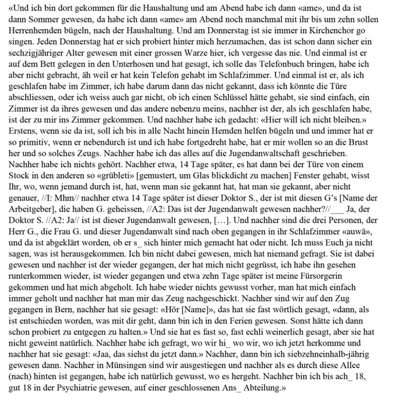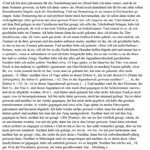Administrative detention as punishment for victims of sexual violence?
 Excerpt of the interview transcript IEC, M.T., p. 4-5
Excerpt of the interview transcript IEC, M.T., p. 4-5 Contents of the source
The passage presented here shows the moment in the interviewee’s biography just before her administrative detention. In the interview, Mrs. T first describes how she was accused of theft already at school. She was the illegitimate child of a poor family and was constantly compared with her mother in a negative way. She was also repeatedly exposed to insinuating and sexualised remarks. She declares that she was never really lucky with the work placements in private households the authorities assigned her after compulsory school and that her bad reputation always preceded her.
Access to the source
Analysed together with other interviews that the IEC conducted with victims of administrative detention, this interview shows that this was a «typical» case history leading to administrative detention in juvenile and adult age: many interviewees were stigmatised as children or adolescents, for example, because they were illegitimate children or because their parents were poor or «strange». During the years at school, this stigma became stronger and stronger. Teachers, priests, neighbours, but also parents or police officers often considered even minor events as «proof» of the stigma cast on these children. Thus, the children and their families moved more and more into the focus of the authorities; in biographies of this kind, compulsory welfare measures at an early age appear frequently. When she was eleven years old, Mrs. T was sent to a children’s home because of alleged theft. The fact that «it had to be your fault», as Mrs. T says in her interview, was part of the stigmatisation of these children and adolescents and made them particularly vulnerable to accusations and attacks on behalf of adults in their social environment.
This interview passage also shows a second «typical» experience in the victims’ biographies: the authorities did not support them when they tried to defend themselves against accusations and attacks of this kind. Mrs. T was not even examined by the magistrate in charge of juvenile affairs, as she declares in the quotation. Instead, she was disciplined by the magistrate, who sent her as administrative detainee to a mental hospital and then to a re-educational institute for «daughters who, after having left school, were difficult to educate and morally exposed».
Analysis
Stigmatised adolescents under guardianship and/or custody and labour arrangements could be interned in an institution very easily if they tried to defend themselves against sexual advances, sexual violence and/or financial exploitation and pressure. Exaggerating, one could say that violence against adolescents subjected to custody arrangements was «solved» by ordering administrative detention to the victims’ disadvantage. The magistrate in charge of juvenile affairs did not examine the young woman about her allegations; on the contrary, the convicting authority (i.e. the magistrate in charge of juvenile affairs) and the employers (among which the culprit) seem to have settled the «problem» among themselves: «I wasn’t there, no one asked me», says Mrs. T. in the interview. In a certain way, by disciplining the victim – and not the culprit –, the victim’s administrative detention justified in retrospect the violence inflicted. This experience is «typical» for victims of administrative detention. The interviewees very rarely describe the criminal prosecution or even the conviction of the culprits and only when they received great support on behalf of «reliable» third parties.
Remarks on the source
This source description is an example out of the analysis of 58 narrative interviews, which were evaluated according to the research methods of «qualitative social research» and «oral history». For details about the way to deal with this kind of source, see the text by A. Schwendener.
R. Ammann/Translation
Source
Excerpt of the interview transcript IEC, M.T., p. 4-5.
 previous source
previous source
 next source
next source


